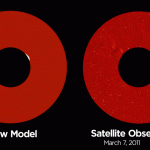NASA observatory captures a rare stretch of our sun without spots0
- From Around the Web, Space
- March 23, 2017
Like a giant egg yolk in the sky

Like a giant egg yolk in the sky

The hellishly hot planet fries spacecraft electronics, so NASA scientists devised a machine inspired by ancient technology.

With a budget $19.508 billion, will NASA be able to get people onto the red neighboring planet?

Time travel is possible, in a way.

As British royal families fought the War of the Roses in the 1400s for control of England’s throne, a grouping of stars was waging its own contentious skirmish — a star war far away in the Orion Nebula.

For the first time, scientists using NASA’s Hubble Space Telescope have witnessed a massive object with the makeup of a comet being ripped apart and scattered in the atmosphere of a white dwarf, the burned-out remains of a compact star.

Earth’s radiation belts, two doughnut-shaped regions of charged particles encircling our planet, were discovered more than 50 years ago, but their behavior is still not completely understood.

The dynamic space environment that surrounds Earth – the space our astronauts and spacecraft travel through – can be rattled by huge solar eruptions from the sun, which spew giant clouds of magnetic energy and plasma, a hot gas of electrically charged particles, out into space. The magnetic field of these solar eruptions are difficult to predict and can interact with Earth’s magnetic fields, causing space weather effects.

Over the past decade, the international Cassini mission has revealed intense activity at the southern pole of Saturn’s icy moon, Enceladus, with warm fractures venting water-rich jets that hint at an underground sea. A new study, based on microwave observations of this region, shows that the moon is warmer than expected just a few metres below its icy surface. This suggests that heat is produced over a broad area in this polar region and transported under the crust, and that Enceladus’ reservoir of liquid water might be lurking only a few kilometres beneath.



